Quality of the Environment in Japan 1994
b. Systemized Countermeasures
Traffic pollution countermeasures are being implemented based on the following:
(a) Countermeasures for emissions of nitrogen oxides in major cities
Vehicle emissions are one reason why there has been little improvement in the problem of air pollution caused by nitrogen oxides in major cities. The effects of existing single restrictions have been offset by a rise in vehicle emissions resulting from marked increases in the volume of motor vehicle traffic and in the percentage of diesel vehicles to trucks as a whole. Because of this situation, there has been no significant decline in emissions, and therefore the following comprehensive measures are being implemented.
1. As will be explained in more detail later, countermeasures for individual vehicles include the further strengthening of regulations on motor vehicle exhaust emissions while promptly switching to lesspolluting vehicles that satisfy the latest emission control standards. Efforts are being made to commercialize such low-emission vehicles as electric vehicles, methanol vehicles, compressed natural gas (CNG) vehicles, and hybrid vehicles. It is necessary to vigorously conduct research and development aimed at enhancing the functions of these vehicles, thereby making them commercially viable in a wide range of areas, while aggressively promoting the widespread use of these vehicles by expanding their applications, which includes introducing them in various fields.
2. Countermeasures for dealing with automobile traffic should include such distribution-related measures as curtailing the volume of truck traffic through improved freight transportation efficiency by shifting from private-use trucks to more efficient commercial-use trucks and undertaking joint distribution ; measures that address the flow of people, including those that aim to restrict the utilization of personal-use automobiles by establishing public transportation systems and increasing the convenience of such systems ; and promoting the smooth dispersion and flow of traffic by installing traffic control systems, improving the structures of intersections, and constructing ring roads while taking into consideration environmental protection. These measures should be carried out on a comprehensive and well-planned basis.
3. To reduce vehicle emissions of nitrogen oxides in specified areas under the Automobile NOx Law, it is necessary to promote the various strategies that are based on the NOx Emission Reduction Plan, which is a specific plan. Also, it is important to determine a special NOx emission standard for trucks and buses registered in specified areas and to strive for the smooth implementation of restrictions on types of vehicles not conforming to standards.
(b) Road Traffic Noise and Vibration Countermeasures
Noise is generated by vehicle engines, exhaust, drive trains, and tires. Besides noise generated directly from motor vehicles, vehicle noise is the result of a complicated mixture of factors, including traffic volume, the types of passing vehicles, their speeds, the road structure, and the land use of roadside areas.
Vibration from traffic along roadsides is also becoming a problem and is the result of a combinations of factors that include vehicle traffic volume, driving conditions and the flatness of the road, the structure of the pavement, and the condition of the roadbed and other road-structure-related factors. For a thorough solution to this problem, it is necessary to implement comprehensive measures that include such source countermeasures as reducing noise from vehicles by improving the structure of vehicles and upgrading driving conditions; implementing traffic flow measures; and introducing road countermeasures, including upgrading the structures of roads (Figure 6-4-5).
Fig. 6-4-5 Road Traffic Noise Countermeasures
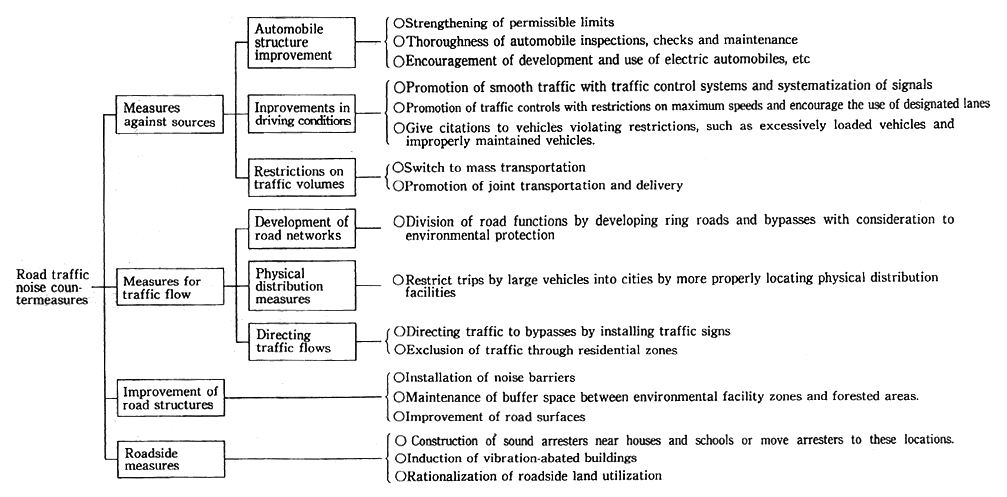
Note : Other measures include the (1) implementation of environmental impact assessments for the construction and renovation of roads, (2) upgrading of monitoring and surveillance systems, (3) promotion of the research and development of technologies for noise prevention, (4) development of new transportation systems, and (5) the use of deucational activities on the rational use of automobiles.
The following are specific measures for dealing with traffic noise:
1. In each area where noise is a problem, upgrade and strengthen existing standards, subsidize noise insulation work for dwellings, and promote the direction of large vehicles to bypasses.
2. As comprehensive countermeasures that take into consideration the characteristics of each region in large cities, place restrictions on the volume of vehicle traffic through distribution countermeasures and measures to restrict the flow of people; restrict the flow of heavy-duty vehicles into city centers by more appropriately locating distribution facilities; promote the rational use of roadside land ; and prohibit large vehicles from passing through cities by building bypasses with consideration for environmental protection along major roads in cities.
3. Efforts should also be made to provide education on reasonable methods for the maintenance, control, and driving of motor vehicles; promote the increased use of less-noisy vehicles; continue to develop various types of technologies for noise reductions; and consider the strengthening of restrictions on individual vehicles.
(c) Establishing an Effective Structure to Promote Countermeasures
For the promotion of countermeasures for road traffic pollution at the national level, the national government will implement necessary measures within a framework of close liaison and cooperation among related ministries and agencies, while providing the necessary support for measures that are carried out at the regional level. Road traffic pollution is a particularly chronic problem in regional areas. To solve this problem, it is necessary to use cooperative councils centered on prefectural and city governments and, when the need arises, government-affiliated institutions, while formulating countermeasures that will effectively address this situation in the region.
In line with the above approach, the Environment Agency has instructed prefectural and city governments on the methods for formulating planned and comprehensive countermeasures for preventing traffic noise pollution and using a concrete approach that responds quickly to the situation in the local community. At the same time, the Environment Agency is carrying out surveys in model communities vigorously promoting strategies for plans to prevent pollution.
In addition, using a fund established in the Pollution-Related Health Damage Compensation and Prevention Association (PHDCPA) under the Pollution-Related Health Damage Compensation and Prevention Law, the Environment Agency is promoting the switch to vehicles that satisfy the latest exhaust gas regulations and carrying out various activities as part of a campaign against air pollution.
In the area of developing countermeasures against noise from road traffic, the Environment Agency is deliberating various effective measures beginning with those for lowering the emission of noise from vehicles. Because it is imperative that these measures be implemented properly, the Environment Agency submitted the report, The Future Policy for Motor Vehicle Noise Reductions, to the Central Council for Environmental Pollution Control on June 11, 1991. On November 30, 1992, the Council presented an interim report, which stated primarily that restrictions on individual vehicles should be strengthened. The Council is also deliberating the promotion of comprehensive countermeasures to further reduce the amount of vehicle noise.
(3) Structural Improvements in Motor Vehicles
a. Measures Against Exhaust Gases
Nitrogen oxides emission controls were first implemented for gasoline- and LPG-fueled vehicles in fiscal 1973 and on diesel-powered vehicles in fiscal 1974. In fiscal 1978, controls on gasoline and LPG passenger cars were strengthened in accordance with the strict target standards contained in the Central Council's fiscal 1972 interim report (annual average nitrogen oxides emission of O.25g/'km) and have been reduced to less than one-tenth of levels emitted during the years when no controls had been exercised.
Controls on motor vehicles other than gasoline and LPG-fueled passenger cars (such as trucks and buses) were first introduced in fiscal 1973-74 and were subsequently strengthened in 1975 and 1977. These controls were then again strengthened from 1979 to 1983 in line with the second-phase targets indicated in a 1977 report issued by the Central Council for Environmental Pollution Control.
Controls on black diesel smoke emitted from diesel motor vehicles (with the degree of pollution not more than 50%) were put into force on new vehicles in 1972 and on existing vehicles in 1975.
As described above, controls on exhaust gas from motor vehicles have been strengthened incrementally. Nevertheless, it is necessary to further reduce the emission of nitrogen oxides and particulate matter in major cities and other areas where traffic volume is significant. For this reason, in 1985, the Environment Agency asked the Central Council for Environmental Pollution Control about future measures for reducing exhaust emissions from motor vehicles. In response, taking into consideration the contents of the 1986 interim report, controls were strengthened by 1990 and included a 15 reduction in the emission of nitrogen oxides from large diesel trucks ; controls on light vans and other lightweight trucks were strengthened to the same level as those for passenger cars. Controls were also strengthened in 1990 and 1992 for a 30% reduction in the emission of nitrogen oxides from diesel-powered passenger cars.
In December 1989, a final report containing the following measures was completed. It stipulated that the measures outlined in the report were to be enforced in two phases, with short-term target values (within five years) and long-term (within 10 years) target values (Tables 6-2-1 and 6-4-3).
(a) Major Reductions in Emissions of Nitrogen Oxides
1. A 30%-60% reduction in the emission levels of nitrogen oxides from diesel-powered vehicles
2. Reduction of the emission levels for direct injection-type engines to the level of the indirect injection-type engines
3. Setting of reduction targets designed to reduce diesel-powered vehicle emissions to the levels of gasoline-fueled vehicles
(b) Introduction of controls on particulate matter and comprehensive reassessment of countermeasures for particulate matter
1. A reduction of more than 60% in the emission levels of particulate matter from diesel-powered vehicles
2. A 50% reduction in the emission levels of black diesel smoke
Table 6-4-3 The Progression of Vehicle Exhaust Controls

Notes: 1. The figures in parentheses for the limit values are average values.
2. are ordinary and small-sized vehicles with a gross vehicle weight of less than 1,700 kg. are ordinary and small-sized vehicles with a gross vehicle weight of more than 1,700kg. and less than 2,500kg. are ordinary and small-sized vehicles with a gross vehicle weight of more than 2,500 kg (excluding passenger vehicles) are light-and medium-duty, light automobiles, and passenger vehicles with a gross vehicle weight of over 2,500 kg. are diesel passenger vehicles with equivalent inertial weight of less that 1,250kg. are diesel passenger vehicles with an equivalent inertial weight of more than 1,250 kg. ELW is equivalent inertial weight. GYW is total vehicle weight.
3. The figures in parentheses in the column for the Enforcement Year are the time of application of regulations on imported vehicles.
4. For exhaust emission controls in 1975, for HC regulations for light vehicles with 2-cycle engines, the period of application was extended to September 30, 1977. (During this time, the provisional control values were 5.6(4.5)g/km for 10 mode inspections and 33(25)g/test for 11 mode inspect-ions.)
(c) Reduce sulfur content in light oil to one-tenth current levels
(d) Review of driving cycle of exhaust emission test.
It is necessary to formulate and implement those measures against road traffic pollution in a comprehensive manner (Fig. 6-4-5).
In line with this report, the Environment Agency carried out procedures for strengthening short-term emission control targets in March 1991. As for long-term targets, the Investigation Committee for Motor Vehicle Exhaust Emission Control Technology established within the Environment Agency convened from October 1990 and continued technical evaluations and resolved to attain long-term targets as soon as possible. The Environment Agency received a report frona the committee in June 1992 and carried out necessary procedures in September and October 1993 for strengthening regulations on medium-duty gasoline-fueled vehicles in 1994 and for heavy-duty gasoline-fueled vehicles in 1995. Also, a report issued by the committee in August 1993 concluded that several types of diesel-powered vehicles could attain long-term targets by around 1997. The report also stated that long-term targets should be attained within 10 years at the very latest, and that in the future, technical development of automobile manufacturers should be promoted, technical evaluations conducted continuously, and targets for other types of vehicle attained as soon as possible.
Studies are being carried out to examine the necessity of implementing new controls for exhaust emissions for two-wheeled and special vehicles, which are not presently covered by vehicle exhaust emission controls.
To promote a reduction of sulfur content in light oil, such measures as cuts in income, corporate, and facilities taxes on oil refiners are being taken.
As a measure to reduce environmental pollution as soon as possible, old diesel trucks and buses should be replaced with vehicles that satisfy the latest controls on exhaust gas. Several measures have been implemented to achieve this objective, including such preferential tax treatment measures as reductions in the automobile tax from 1990 to 1993, a cut in the vehicle ownership tax, and a special depreciation system as well as low-interest financing by such agencies as the Japan Development Bank, Smaller Business Finance Corporation and other financial institutions for the replacement purchase of vehicles.
b. Noise Reduction Measures
As a measure to reduce the volume of noise from vehicles and improve vehicle structure, there are noise restrictions, which are being implemented for all automobiles and motor driven cycles. These noise controls are classified into three categories accelerated running noise, which is the loudest type of vehicle noise; steady running noise, emitted when a vehicle is driven at constant speed; and proximity stationary noise, which is suitable for control on the street.
Since they were first implemented in 1971, controls of accelerated running noise on new vehicles have been strengthened several times. A strengthening of these controls in 1979 was made in line with the establishment of target values for permissible noise limits for accelerated running noise that were contained in a report issued by the Central Council for Environmental Pollution Control in June 1976. Proximity stationary noise controls, which are suitable for control on the street, were started in June 1986 and cover vehicles in use. These measures are instrumental in controlling illegally altered automobiles and have played a vital role in reducing and preventing noise.
In spite of such intensification of regulations, the compliance rate of environmental quality standards was still at a low level mainly in the areas along the major roads due to an increase in traffic, etc. As it was necessary to further reduce traffic noise, the Director General of the Environment Agency asked, in June, 1991,the Central Council for Environmental Pollution Control to deliberate on "The Future Policy for Motor Vehicle Noise Reduction." In November 1992, the Council presented an interim report in which target values for permissible limits (accelerated running noise) to reduce the noise by 1 through 3 dB, depending on the type of vehicle. The target values contained in the report are the world's strictest. In line with the contents of this report, the Environment Agency is striving to strengthen vehicle noise controls.
(4) Promoting the Increased Use of Low-Emission Vehicles
Monitoring and surveys are being carried out to promote the use of low-emission vehicles, especially in major urban areas. Also, the Environment Agency and the Ministry of International Trade and Industry are utilizing electric cars as public-use vehicles and are conducting studies on the commercialization of such vehicles. Other ongoing measures include national subsidies to promote the use of such low-emission vehicles as pollution patrol cars by local governments and subsidies from the PHDCPA fund to promote the use of electric vehicles and methanol vehicles. In fiscal 1993, a subsidy system was established for the purchase of low-emission vehicles by the operators of buses on public bus lines in areas designated as specified regions under the Automobile NOx Law. Special tax measures have also been established, including a lowering of the automobile possession tax and the automobile acquisition tax for electric vehicles, methanol vehicles, hybrid vehicles, and natural gas vehicles. From October 1992 to September 1993, as part of the government's economic stimulus program, special depreciation measures related to individual and corporate income taxes and tax deductions were allowed for the acquisition of filling equipment for methanol and natural gas vehicles. To publicize and encourage the wider use of low-emission vehicles and foster a deeper understanding of these vehicles among the public, a number of measures were implemented, including the holding of fairs featuring low-emission vehicles at 12 locations across the nation in fiscal 1993 and conducting trial development of a solar-powered car using the PHDCPA's fund. To promote the development of low-emission vehicles, following the formulation of technology guidelines for methanol cars in June 1992, in December 1993, deliberations began on a uniform evaluation of exhaust gas capabilities for natural gas, hybrid, and other low-emission vehicles and the formulation of technical guidelines for gas emissions to serve as development targets. To establish a network of fuel supply stations for low-emission vehicles, 20 sites for such filling stations were selected under the Eco-Station 2000 Plan. The previously mentioned measures, as well as other measures for promoting the greater use of low-emission vehicles, are shown in Table 6-4-4.
Table 6-4-4 Use of Low-Emission Vehicles and Government Policies to Encourage Their Use in Japan
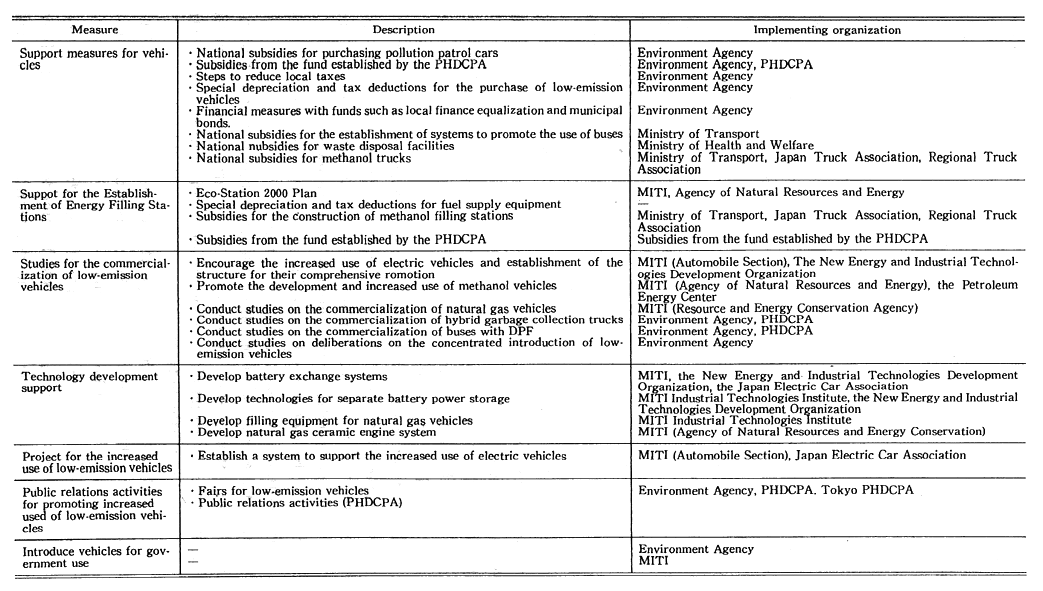
(5) Traffic Control
Maintaining a safe and smooth flow of traffic is important for the sake of reducing air pollution, noise, and vibration caused by motor vehicle traffic. The following measures for the prevention of road traffic pollution are taken by the police, who are acting from the perspective of road management authorities.
(a) On main arterial roads, reduce stop-and-go driving at intersections by installing traffic control systems and advanced traffic signals and by reviewing and inspecting various types of traffic control systems. By upgrading the collection and provision of information, beginning with the use of systems that monitor and display information on travel times, authorities are striving to better direct traffic flow and promote a more even balance in the volume of traffic, while reducing vibrations, noise, and emissions of nitrogen oxides and carbon dioxide, which causes global warming.
(b) Make efforts to improve the environment, primarily in cities, through the effective implementation of various types of traffic controls. Principal examples are as follows :
1. Make efforts to maintain a good living environment by establishing several types of residential and "living" zones and, depending on the characteristics of the zones, implement and combine various traffic controls such as prohibiting the passage of large vehicles.
2. Shift to the use of public mass transit by designating bus lanes and by introducing the park-and-ride system.
Encourage less use of private vehicles and increased use of mass public transit through such measures as designating special bus lanes and giving priority to public transportation organizations and controlling the volume of vehicle traffic.
3. Designate certain lanes for specific types of vehicles, such as requiring large vehicles to use inside lanes, as part of efforts to reduce noise and vibration from large vehicles.
(c) Install prevention systems and traffic-guidance systems to eliminate the problem of illegal parking, which impedes the smooth flow of traffic in large cities. At the same time, concentrate on strictly regulating and making citations for illegal parking that is a danger and hindrance to a smooth flow of traffic.
(d) A recent sharp rise in complaints from citizens about loud motorcycle noise by motorcycle gangs has prompted a revision in Road Traffic Laws and more strict police regulation. As a result, the number of calls made by citizens using police emergency lines has declined. During 1993, 7,179 police citations were made against motorcycle gangs and others for muffler-related infractions.
(e) Regulations have also been tightened and a portion of Road Traffic Laws revised in response to the problem of overloaded vehicles, a major cause of noise and vibration. There were 91,613 citations given in 1993 for vehicle overloading. Also, to prevent noise caused by highspeed driving, such measures as the installation of high-speed driving prevention systems have been implemented.
(6) Improvements in Road Structure and the Roadside Environment
A smooth and even flow of traffic is being attained by systematically establishing a road network that includes bypasses and ring roads. Traffic congestion is being relieved and the environmental burden reduced by improving road intersections and installing new traffic systems and parking lots and parking lot guidance systems. Also, research and development is progressing in such fields as new distribution systems that use the space underneath arterial roads. For the construction of bypasses, necessary environmental impact studies are being carried out as part of efforts to prevent pollution.
Efforts to improve the structure of roads include the establishment of environmental facility zones and the installation of noise arresters, planting trees and greenery along roads, and improving road surfaces.
As of the end of fiscal 1992, seven routes with a total length of about 105 kilometers were designated to become roads based on the Law for the Improvement of Roadside Areas along Trunk Roads.. A portion of this plan includes 63.3 kilometers in 26 wards, including 0.8 kilometers in Nerima Ward along the Haneda-Takaido-Iwabuchi Route (Loop No. 8). As part of this plan, sharing of the costs for the construction of buffer structures, subsidization of the construction of noise arresters, and no-interest loans for land purchases by municipalities are based on the Law for the Improvement of Roadside Areas along Trunk Roads. As an emergency measure along national expressways, where noise is particularly acute, subsidized soundproofing was carried out at 48,000 houses by the end of fiscal 1993.
With the aim of improving of the roadside environment, longterm, low-interest financing for construction of buildings has been carried out since 1985. Also, as part of road management, road management authorities are collecting and disseminating road traffic information, while making efforts to preserve the roadside environment by enforcing laws against overloaded trucks. In fiscal 1992, there were 7, 688 citations issued for overloaded trucks.
(7) Enhancing the Efficiency of Distribution
To solve the problem of air and noise pollution and vibration caused by vehicles, along with measures targeted at vehicles, it is vital to create highly efficient distribution systems as well as traffic systems that minimize pollution..
From this perspective, efforts are being made to prevent pollution from traffic through the implementation of the following measures to enhance the efficiency of distribution.. Between medium- and longdistance distribution bases on principal arteries, to promote a shift way from the use of trucks toward greater reliance on more transportationefficient railroads and maritime shipping, it is necessary to establish a foundation for increasing railway freight-handling capabilities, including the implementation of a preferential tax treatment system for purchasing equipment for integrated transportation and the use of various types of financial support measures. At the same time, it is important to establish more-flexible operational systems for adjusting cargo space on ships by using container ships with internal containers, RORO ships, and internal freight unit road terminals.
For regional distribution, it is necessary to efficiently use truck transportation. Therefore, while encouraging a shift away from the utilization of private-use trucks toward more-efficient commercial trucks, combined loading by business trucks is being vigorously promoted. Also, as part of efforts to construct rational distribution systems, access roads are being established for principal distribution bases, including airports and seaports, such distribution bases as warehouses and truck terminals are being consolidated and more appropriately located, and there has been an aggressive shift toward the use of larger trucks.
6-4-3 Measures for Aircraft Noise
The use of jet aircraft has dramatically increased the convenience of transportation. Unfortunately, the use of jets has also caused noise problems around airports. In particular, along with the urbanization taking place around airports, there have been lawsuits for damages and for bans on night landings and take-offs at such civilian airports as Osaka International Airport and Fukuoka Airport as well as at such defense facilities as Komatsu Air Base, Yokota Air Base, Atsugi Air Base, and Kadena Air Base. The lawsuits other than those related to Osaka International Airport and Yokota Air Base (1st and 2nd stages) and Fukuoka Airport have yet to be settled. In the suit against Osaka International Airport, arbitration was concluded with the assistance of a mediators' committee, and in December 1990, a decision on whether to retain or abolish the airport by the time of the opening of the new Kansai International Airport was made in favor of retaining the airport. This decision was the result of a compromise between the mediators' group, which was formed by residents around the airport and other people, and the related local governments. It was also decided to continue implementing measures to reduce noise.
(1) Establishment and Achievement of Environmental Quality Standards
(a) Environmental Quality Standards
The Environmental Quality Standards for Aircraft Noise (December 27, 1973), which targets various measures to prevent aircraft noise pollution, were created so that the weighted equivalent continuous perceived noise level (WECPNL) could be established according to the classification of the type of region. To this end, these levels have been established at less than 70 WECPNL for areas used only for residential purposes and less than 75 WECPNL for areas where there is a need to maintain a normal daily life. The governors of the various cities and prefectures determine the classifications for the regions when applying these standards. As of the end of fiscal 1992, classifications of areas had been made around 58 airports in 32 cities and prefectures.
(b) The Attainment of Environmental Quality Standards
With the exception of a few airports, environmental quality standards had yet to be achieved at airports that had deadlines as of December 31, 1993 for attaining environmental quality standards or for the attainment of 10-year improvement targets. Nevertheless, there has been an overall reduction in noise pollution in areas around Tokyo International, Osaka International, and Fukuoka airports compared with the time when the environmental quality standards were first implemented.
Heliports, which have become increasingly common across Japan over the past several years, and other such small facilities are not subject to the application of environmental quality standards. With the aim of preventing noise pollution from these facilities, the Environment Agency notified local governments in September 1990 about guidelines for environmental protection.
(2) Measures Against Noise Sources
The most basic and effective noise countermeasures are those that significantly reduce noise from aircraft, the source of the noise. The introduction of quieter aircraft and the adoption of less noisy flight operations have played an important role in responding to increased air transportation volume and reducing noise in those areas adversely affected.
(a) Introduction of Quieter Types of Aircraft
A certification system banning the operation of aircraft whose noise exceeds prescribed levels has been in effect since 1975 and this system was strengthened in 1978. While aggressively introducing quieter aircraft (such as the B-767) at principal airports, beginning with Osaka International Airport, where noise is a serious problem, the phasing out of noisy aircraft is progressing and, in principle, the operation of such models with high noise levels as B-707s and DC-8s was prohibited from January 1988. Also, the last B-727 was taken out of service on domestic airline routes in April 1990.
From the perspective of implementing further aircraft noise countermeasures, a portion of the Aircraft Law was revised and various procedures are being carried out so that the operation of those aircraft that conform to the old noise standards,which correspond to the standards of 1975, will be gradually restricted from April 1, 1995, and the operation of such aircraft will be prohibited from April 1, 2002.
(b) Restrictions on Take-offs and Landings
With the exception of emergencies, the take-off and landing of jet aircraft is forbidden from 11 p.m. to 6 a.m. at New Tokyo International Airport (Narita) and Tokyo International Airport (Haneda) and from 10 p.m. to 7 a.m. at Osaka International Airport. Furthermore, at Osaka International Airport, no regular flights can be scheduled after 9 p.m.
Also, since October 1977, the maximum frequency of take-offs and landings for Osaka International Airport has been established at 370 times a day, including 200 times for jet aircraft. However, along with the progress in dealing with noise sources and area countermeasures, the increased use of jet aircraft at regional airports, and the need to respond to the aging of YS-lls, in October 1988 the "maximum number of daily allowable take-offs and landings for jets was increased (50 times per day) to promote a shift away from the use of the YS-11." As a result, the shift away from the operation of the YS-11 toward quieter jet aircraft has made gradual progress. This was intended as a provisional measure until the September 1994 opening of the new Kansai International Airport and was implemented after taking into account various environmental considerations.
In May 1992, the permissible number of jet take-of fs and landings was expanded by 50 times a day at regional airports in response to the increased use of jets as replacements for YS-lls, and this was gradually implemented from July of the same year.
(c) Lower-Noise Flight Operations
Depending on the location of each airport, it is desirable to give priority to the use of certain runways and flight routes and to use rapid climb and cut-back climb methods, low-flap angle take-offs and landings, and delayed flap approaches.
(3) Noise Measures for Areas Around Airports
For areas that will still be affected by noise caused by aircraft even when measures against noise sources are implemented, various measures have been taken in accordance with the Law Concerning the Prevention of Damage Caused by Aircraft Noise in Areas Around Public Airports. Measures taken under this law have been applied to 15 specific airports, including Tokyo International Airport (Haneda), Osaka International Airport, and Fukuoka Airport. These measures include providing subsidies for the installation of noise insulation for schools, hospitals, dwellings, and other facilities for joint use; compensation for moving to other areas ; the development of green buffer zones; and the subsidization of television subscription fees (Table 6-4-5).
Table 6-4-5 Activities Carried Out as Noise Countermeasures Around Airports
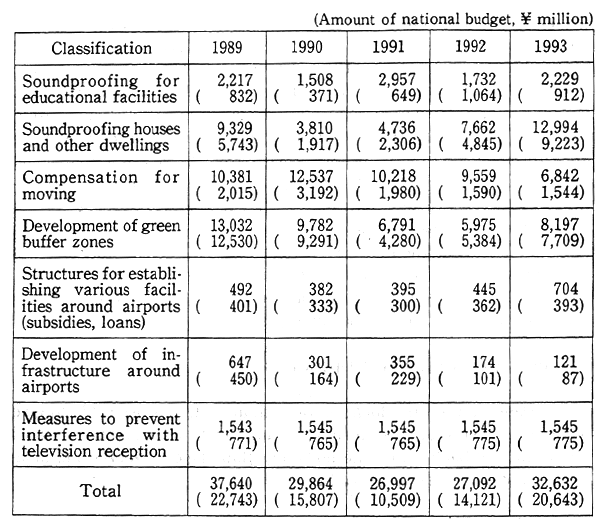
Notes:1. Surveyed by the Ministry of Transport.
2. The figures in parentheses are the amounts budgeted for the Osaka International Airport.
3. The expenditure for surveys are excluded.
Because of urbanization around the Osaka International Airport and Fukuoka Airport, these airports have been designated as airports that require the planned implementation of various measures in the surrounding areas under the previously mentioned law. The Organization for the Development of Areas Around Airports, which was established jointly with funds from the national government and the related local governments, in addition to the preceding activities is carrying out redevelopment projects and projects for the development of alternative sites based on the Development Plan for Areas Around Airports that was formulated by the governors of affected prefectures.
As a result of progress in projects for surrounding areas, noise insulation work for homes and other dwellings was nearly completed as of fiscal 1985, and indoor environment standards were attained as specified by targets in the Environmental Quality Standards for Aircraft Noise.
(a) The Ministry of Transport and the Osaka city government have established 50 hectares of greenbelt areas in Osaka city around Osaka International Airport. In February 1987, an urban plan was formulated, and approval to implement this plan in a portion of the designated areas was received in January 1988. This plan is being steadily carried out. Also, in Hyogo Prefecture, an urban plan calling for the establishment of 8.6 hectares of greenbelt was decided in March 1993, and permission to carry out such activities under the plan was received the following September.
(b) Using vacated land around the Hakodate, Sendai, Osaka International, Matsuyama, Kochi, Fukuoka, and Miyazaki airports, regional authorities are providing subsidies for the establishment of a surrounding infrastructure, including parks and greenbelts.
Also, under the Special Measures Against Aircraft Noise at Specific Airports Law, the Basic Policies for Countermeasures Against Airport Noise was formulated by the Governor of Chiba Prefecture to achieve appropriate land use in the area surrounding the New Tokyo International Airport (Narita). Based on these policies, an urban plan has been formulated for various areas for preventing noise damage from aircraft.
(4) Measures Against Aircraft Noise Around Defense Facilities
It is difficult to reduce engine noise around airfields used by the Self-Defense Forces because of the essential function and purpose of these forces. Therefore, principal noise reduction and flight operations measures for these facilities include the use of noise mufflers and controls on flight patterns. For countermeasures against noise sources and flight operations by the U. S. armed forces in Japan, cooperation is sought through such organizations as the U. S.-Japan Joint Committee
Aircraft noise countermeasures for the areas surrounding airports used by the Self-Defense Forces and the U. S. armed forces are based mainly on the Law Concerning the Improvement of the Living Environment around Defense Facilities and include subsidizing noise -reducing insulation for schools, hospitals, and homes; providing compensation for the relocation of buildings; subsidizing land purchases; developing green buffer zones; and providing subsidies for television subscription fees (Table 6-4-6).
Table 6-4-6 Projects to Prevent Noise in Areas Around Defense Facilities
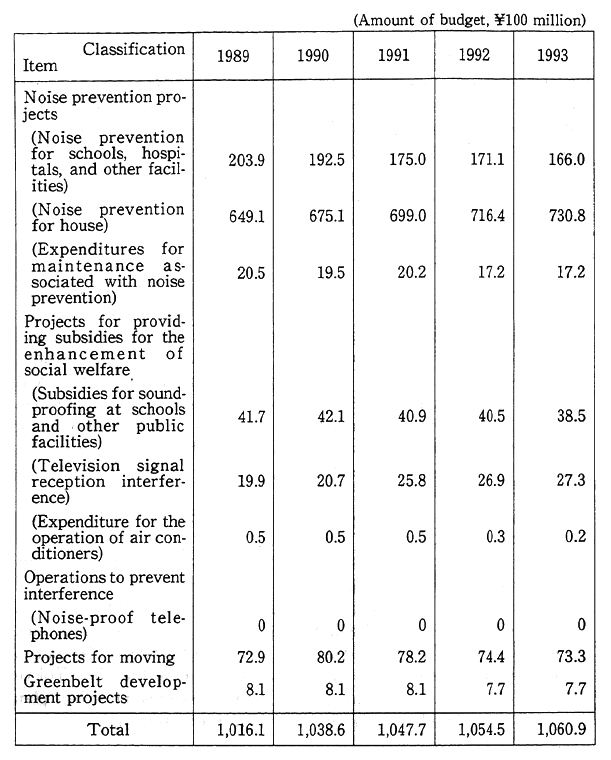
Notes:l. Surveyed by the Defense Agency.
2. The figures in the table include some measures other than those against aircraft noise.
3. Because each number has been rounded off to the nearest whole number, in some cases the figures do not add up to the totals.
As of the end of fiscal 1993, subsidies were provided for noisereducing insulation for houses, and other measures were implemented in areas around 25 airports, which were designated as type 1 areas based on the law. The previously mentioned countermeasures for preventing noise in the areas surrounding airports used by the Self-Defense Forces will continue to be implemented and upgraded.
6-4-4 Measures Against Noise and Vibration of Shinkansen Trains
Since the Tokaido Shinkansen Line went into operation in 1964, the Shinkansen bullet train system has developed as a means of highspeed mass transportation. Nevertheless, the operation of this train system has led to a number of serious environmental problems, including noise and vibrations in some areas along Shinkansen lines. In March 1974, a lawsuit was filed for damages and for stopping noise and vibration along the Tokaido Shinkansen line in the Nagoya area. In April 1986, an amicable settlement was reached, which included further implementation of measures against noise and vibration sources.
(1) Establishment and Achievement of Environmental Quality Standards
(a) Environmental Quality Standards
The Environmental Quality Standards Associated With the Noise of Shinkansen Trains (July 29, 1985), which serves to set targets for measures against Shinkansen train noise, stipulates that, depending on the type of surrounding area, noise levels shall be less than 70 dB for areas that are primarily used for housing purposes and less than 75 dB for areas used for commercial, industrial and other purposes. It also stipulates that efforts shall be made to attain or maintain these levels. (N ote: Because of a revision in measurement methods, the unit for measuring noise has been changed from phons to decibels).
The classification of trackside areas is made by prefectural governors in all 21. prefectures through which Shinkansen railway lines run.
For the smooth attainment of these standards, at a cabinet meeting held in March 1976, the government approved the Outline of Measures Against the Noise of Shinkansen Trains in which basic matters about countermeasures against noise sources and noise pollution prevention were stipulated. In advance of the decentralization and privatization of the Japanese National Railways, the Cabinet once again approved the Promotion of Measures Against the Noise of Shinkansen Trains after the Reorganization of the Japanese National Railways in March 1987 and also decided to continue implementing noise countermeasures and to maintain the strategies in the previously mentioned outline of measures for the companies taking over Japanese National Railways' operations and the Japan Railways Construction Organization. For vibration generated by Shinkansen trains, in March 1976, the Minister of the Environment Agency advised the Minister of Transp ortation in a report entitled Urgent Measures for Environmental Conservation to Respond to Vibration by Shinkansen Trains.
(b) Attainment of Environmental Quality Standards
An examination of the attainment of environmental quality standards for noise along the Tokaido and Sanyo Shinkansen lines as well as areas to the north of Omiya on the Tohoku and Joetsu Shinkansen lines reveals a considerable number of areas where the environmental quality standards have not been attained even though the last year in the target period has passed. Because of this, the Environment Agency required related institutions to further promote measures, including the reduction of noise levels to less than 75 dB in the densely populated residential areas along the Tokaido and Sanyo Shinkansen lines and in increasingly densely populated areas along the Tohoku and Joetsu Shinkansen lines by the end of fiscal 1990. (These are called "75 phons areas.") In fiscal 1991, the Environment Agency investigated to what extent the objectives of countermeasures based on those requirements were being attained. The results of this investigation reveal that the overall attainment rate (the percentage of monitoring points where noise levels were below 75 dB) in areas with noise level standards set at less than 75 dB was 76%, a clear indication that there were still some areas not attaining environmental quality standards for noise (Table 6-4-7).
Table 6-4-7 Noise in Areas with "75 Phons Measures" Taken
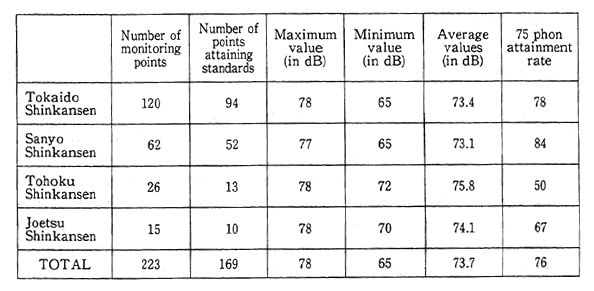
Notes:1. Number of points attaining targets= the number of monitoring stations recording noise levels less than 75 dB.
2. Rate of attainment for 75 phons= number of monitoring points attaining required levels/total number of monitoring points×100.
Reference: Environment Agency of Japan.
Because of this situation, the Environment Agency required related institutions to take necessary measures to attain the target level of 75 phons in the shortest possible time; continue to implement measures to attain noise levels in other regions within the designated areas ; and to make progress with noise source countermeasures, including expanding the number of "75 phons areas. "
An investigation of attainment rates for vibration based on the vibration guideline values (70 dB) recommended by the Environment Agency in March 1976 was carried out. This investigation revealed that along the Tokaido and Sanyo Shinkansen Lines, with the exception of some areas close to the railway tracks, the guideline values were met in most areas following a revision of train schedules in November 1986. The investigation also showed that guideline values (70 dB) were met at all points along the Tohoku and Joetsu Shinkansen lines.
(2) The Implementation of Countermeasures
Following an advisement from the Ministry of Transportation, East Japan Railways, Japan Railways Tokai, and West Japan Railways implemented the measures against noise and vibration sources and the prevention of damage based on the previously mentioned Outline of Measures Against the Noise of Shinkansen Trains (approved by the cabinet in March 1976) and the Minister of the Environment Agency's recommendations (March 1976).
(a) Measures Against Noise and Vibration Sources
For the densely populated stretches along the Tokaido and Sanyo Shinkansen lines and along the Tohoku and Joetsu Shinkansen lines, comprehensive countermeasures have been implemented against noise and vibration sources, including the installation of new types of soundproof walls and the laying of ballast mats. From fiscal 1992, the types of measures implemented were expanded for the densely populated stretch along with Tokaido and Sanyo Shinkansen Lines and the stretch along the Tohoku and Joetsu Shinkansen lines. These new measures against noise and vibration sources included raising noise-prevention walls, installing -improved noise-prevention walls, deeper shaving and smoothing of rail tracks, and installing pantograph covers.
(b) Damage Prevention Policies
Subsidies have been provided for noise insulation work in houses located in areas where noise levels exceed 75 dB as well as for schools and hospitals in areas where noise levels exceed 70 dB. These subsidies are available to all eligible households requesting them. Also, compensation for moving and subsidies for the installation of noise insulation is provided for all houses along the Tokaido Shinkansen lines and the Sanyo Shinkansen lines where vibrations exceed 70 decibels. These are available to all households requesting them, where needed.
(3) Research and Development on Technologies to Prevent Noise and Vibration
Up until 1986, research and development was carried out by Japan National Railways to effectively implement noise source and damage prevention measures. Following the privatization of the railways and establishment of separate companies, testing and research has been carried out mainly by The Railway Comprehensive Research Center. In fiscal 1993, to further reduce noise from Shinkansen trains, the center continued to conduct research on aerodynamic noise reduction measures.
(4) Noise and Vibration from Conventional Railway Trains
Regarding conventional railway trains-those other than the high-speed Shinkansen trains-problems also include complaints about noise and vibration. In particular, problems emerged about noise and vibration as a result of the opening of the Tsugaru Strait Line and the Seto Ohashi Line in 1988. Various measures have been taken to address these problems.
For each of these problems, the Environment Agency, while contacting related organizations, has been taking appropriate measures. However, in instances where there are concerns that the construction of a new line will lead to noise problems, it is necessary to establish guidelines to protect the environment in areas along the tracks as a preemptive countermeasure. At present, such guidelines are being deliberated.
6-5 Noise: Present State and Countermeasures
6-5-1 The Current Situation
Of all pollutants, noise is the most serious problem in everyday life. Also, because there are many sources of noise, this type of environmental pollution produces the greatest number of complaints every year.
An examination of the number of complaints by source shows that factories and work sites account for the largest number of complaints, followed by construction activities, and late-night business activities (Figure 6-5-1).
Although in recent years the overall number of noise complaints has fallen, family-related complaints have remained level.
Fig. 6-5-1 Trends in the Number of Noise Complaints
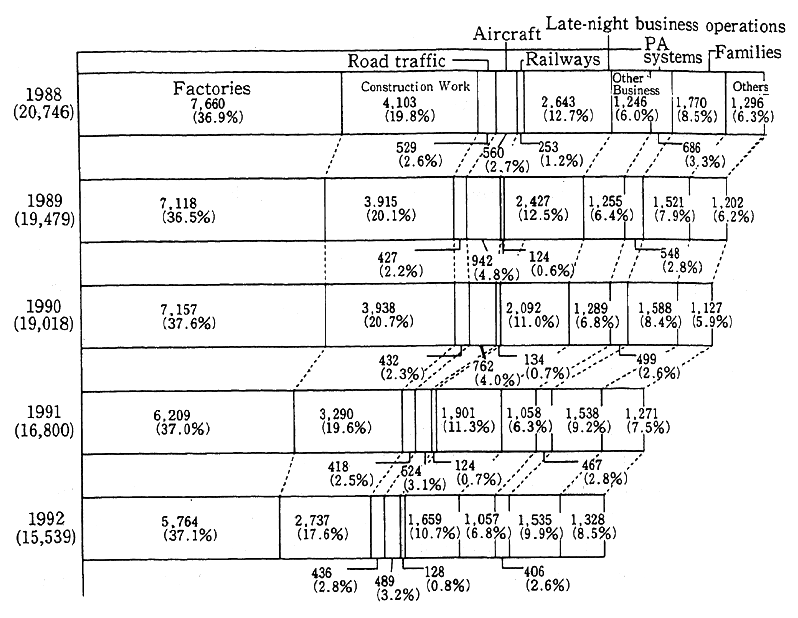
6-5-2 Countermeasures Against Noise
(1) Environmental Quality Standards for Noise
Environmental quality standards for noise were formulated on May 25, 1971, based on Article 9 of the Basic Law for Environmental Pollution Control. The law stipulates that standard values are to be classified into types of areas-one for general areas and one for roadside areas. Each of these areas is further classified into type of region and time of day.
For general areas, the standard values are set as less than 35 dB during the late-night hours in areas for which quiet is particularly required and less than 60 dB during the daytime in commerce and industrial areas that include a considerable number of dwellings. The standard values for roadside areas are higher (5-10 dB) than those for general areas and are determined by the number of lanes and other factors.
Prefectural governors designate areas to which such classifications are applied. The designation of areas was made for 601 cities, 866 towns, 101 villages, and Tokyo's 23 wards, in 47 prefectures as of the end of fiscal 1992.
(2) Controls under the Noise Regulation Law
Controls under the Noise Regulation Law are applied to preserve the living environment by preventing noise in those regions designated by governors (this responsibility is entrusted to mayors of cities designated by the Local Government Law) of prefectures and cities and cover noise generated by factories and other types of work sites as well as noise from construction work.
The designation of areas by prefectural governors (or by mayors in cities designated by the Local Government Law) was made for 661 cities, 1,222 towns, 177 villages, and Tokyo's 23 wards, in 47 prefectures as of the end of fiscal 1992, accounting for about 64% of all municipalities across the nation.
(a) Noise from Factories and Work Sites
In designated areas, there are controls on factories and work sites (hereafter referred to as "specified factories") that have installed special facilities such as metalworking machinery as stipulated by government ordinances. At the end of fiscal 1992, the number of specified factories on which regulations were implemented was 201,735.
It is mandatory for specified factories in designated areas to adhere to these standards. When it is recognized that the surrounding living environment is adversely affected because noise from specified factories did not attain regulatory standards, prefectural governors (delegated to mayors) can make recommendations for changes in programs and for improvements and issue orders for improvements. In fiscal 1992, there were 5 cases where recommendations for improvement were made and 1 case where an improvement was ordered. In addition to steps taken under the Noise Regulation Law, there were 1,115 cases in which administrative guidance was made following investigations after the receipt of reports and other inquiries in response to complaints.
Along with rapid urbanization, residential areas have been built in suburbs around factories that were already in operation, and noise from factories in suburban areas has become a conspicuous problem in recent years. Therefore, surveys and deliberations on countermeasures for such noise have Seen made (surveys and deliberations on countermeasures against noise from factories in areas where population has grown rapidly). There has also been deliberation about expanding the application of legal restrictions to include facilities and construction work currently not covered. For noise pollution in areas where there is a mixture of houses and factories, important steps taken as countermeasures include such prevention measures as the installation of noise barriers and relocating businesses and factories away from the problewis areas. Nevertheless, many of the factories and businesses causing the noise pollution are small and medium enterprises for which moving would be difficult from a financial perspective. Therefore, financing for such relocation is being provided by such institutions as the Small and Medium Enterprise Finance Corporation and the construction of buildings for use by multiple business tenants is being carried out by the Japan Environment Corporation.
(b) Noise from Construction Work
Of all construction work in designated areas, controls are implemented on specified construction work, including pile driving, as stipulated by government ordinance. In fiscal 1992, there were 38,186 cases where reports were filed about the implementation of specified construction work.
When it is recognized that the surrounding living environment is being severely affected because noise from specified construction activities does not attain noise regulatory standards, prefectural governors can make recommendations for improvements and issue orders for improvements in categories covered by the Noise Regulation Law. In fiscal 1992, there were no cases where recommendations or orders for improvements were made. There were 521 cases in which administrative guidance was made after investigation following the receipt of reports and complaints about noise
(3) Neighborhood Noise
In recent years, complaints about neighborhood noise, including noise from late-night business operations, noise caused by loudspeaker announcements, and noise from everyday activities, has accounted for approximately 39% of all noise complaints. Devising countermeasures for neighborhood noise has become a vital task. From the perspective of aggressively providing support for the prevention of noise in people's daily lives, as part of efforts to improve the urban living environment (amenity), model workplaces (sound environment model cities) that incorporate such methods as soundscape as well as various types of information dissemination activities are being carried out.
Also, deliberations and surveys have been conducted on the prevention of noise through flooring, which is becoming a large problem in recent years in multiple dwelling residences.
The Noise Regulation Law stipulates that regional authorities must institute necessary measures to control noise from late-night operations as well as noise from any type of broadcasting activity that involves the use of a loudspeaker. To the present, controls have been exercised under ordinances in 39 cities and prefectures against noise from late night business operations and in 42 cities and prefectures for noise caused by loudspeaker announcements.
6-6 Vibration-Present State and Countermeasures
6-6-1 The Current Situation
Along with noise, vibration is one form of pollution that seriously affects people's everyday lives. An examination of trends in the number of complaints about vibration reveals a downward trend after 1988. In fiscal 1992, there were 2,193 complaints about vibrations. Complaints about vibrations from construction work accounted for the highest proportion of all complaints. This was followed by complaints about vibrations from factories and business sites (Figure 6-6-1).
Fig. 6-6-1 Trends in Vibration Complaints
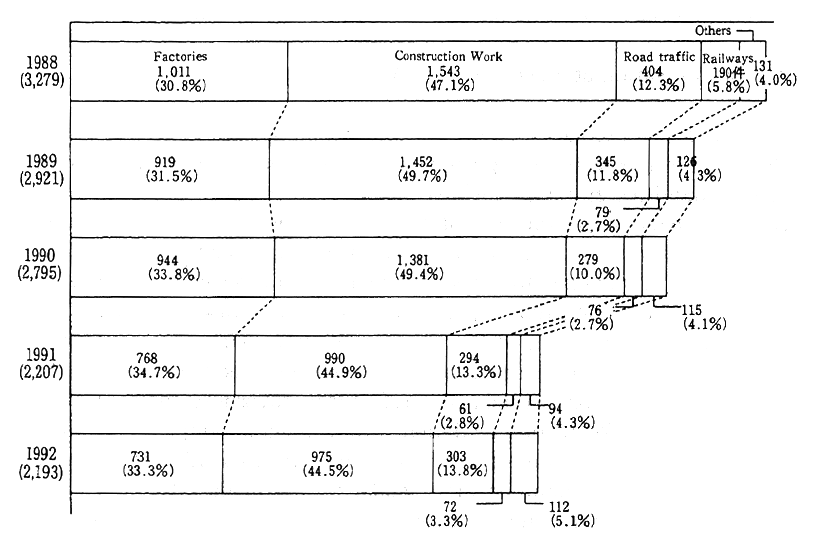
6-6-2 Measures Against Vibration
(1) Controls under the Vibration Regulation Law
Under the Vibration Regulation Law, prefectural governors (or mayors of cities designated under government ordinance) can designate areas where there is a need to regulate vibrations to preserve people's living environments. In these designated areas, they can also implement necessary regulations on vibrations caused by business activities at factories and other workplaces as well in areas where there is vibration from construction activities. In addition, they can request public welfare committees in prefectures or road administrators to take action against road traffic vibration.
As of the end of fiscal 1992, vibration control areas were designated in 650 cities, 852 towns, 99 villages and 23 wards, in 47 prefectures, accounting for about half of all municipalities across the nation.
(a) Vibration at Factories and Work Sites
In designated areas, there are controls on factories and work sites (hereafter referred to as "specified factories") that have installed such special facilities as metalworking machinery as stipulated by government ordinances. At the end of fiscal 1992, the number of specified factories on which vibration regulations were implemented was 114,706.
It is mandatory for specified factories in designated areas to adhere to these vibration standards. Under the Vibration Regulation Law, when it is recognized that the surrounding living environment is adversely affected because vibration levels from specified factories do not attain regulatory standards, prefectural governors (delegated to mayors) can make recommendations for changes or improvements in programs and issue orders for improvements. In fiscal 1992, there were 196 cases in which administrative guidance was made after investigations following the receipt of reports and complaints about vibrations.
For vibration pollution that has become a problem in areas where there is a mixture of houses and factories, important steps taken as countermeasures include such vibration prevention measures as the installation of vibration prevention devices, and such vibration pollution prevention measures as relocating businesses and factories away from the problem areas. Nevertheless, many of the factories and businesses causing the vibration problems are small and medium enterprises, for which moving would be difficult from a financial perspective. Therefore, financing for relocation is being provided by such institutions as the Small and Medium Enterprises Finance Corporation, and the construction of buildings for multiple business tenants is being carried out by the Japan Environment Corporation.
(b) Vibration from Construction Work
For construction work in designated areas, controls are implemented for specified construction work, including pile driving, as stipulated by government ordinance. In fiscal 1992, there were 25,755 cases where reports were filed about the carry.ing out of specified construction work.
When it is recognized that the surrounding living environment is severely affected because of vibration levels from specified construction activities that do not attain vibration regulatory standards, prefectural governors can make recommendations for improvements and issue orders to take steps for improvement in areas related to the Vibration Regulation Law. In fiscal 1992, there were no cases where recommendations or orders for improvement were made regarding vibrations. There were 237 cases in which administrative guidance was made after investigations following the receipt of reports and complaints about vibrations. Regarding vibrations from construction, the development and greater use of low-vibration construction machinery and construction methods is being carried out.
(2) Countermeasures for Unrestricted Vibration Sources
More than half of all the complaints about vibrations come from facilities and activities not covered by vibration controls. Because of this situation, a study on vibrations from uncontrolled facilities was carried out.
(3) Measures Against Low-Frequency Noise
There have been more than 30 cases across Japan in which low-frequency noise, which is barely audible to humans, caused vibration of glass windows, doors, and shoji (Japanese-style wood-framed paper sliding doors) or had an effect on humans. More than half of these cases were caused by factories and places of business. From the surveys and research that have been performed, no data has been acquired that proves that the human body is affected by such vibrations at the levels existing in the normal environment.
6-7 The Present State of Offensive Odors and Countermeasures
6-7-1 The Current Situation
In recent years, although there has been a downward trend in the number of complaints about offensive odors, the number of complaints rose slightly in fiscal 1992, to 10,753. By industry source, for the first time ever, the service sector accounted for the largest percentage of complaints, making up 24% of all complaints. This was followed by the livestock and agriculture industries, with about 23% (Figure 6-7-1).
Fig. 6-7-1 Trends in Complaints about Offensive Odors
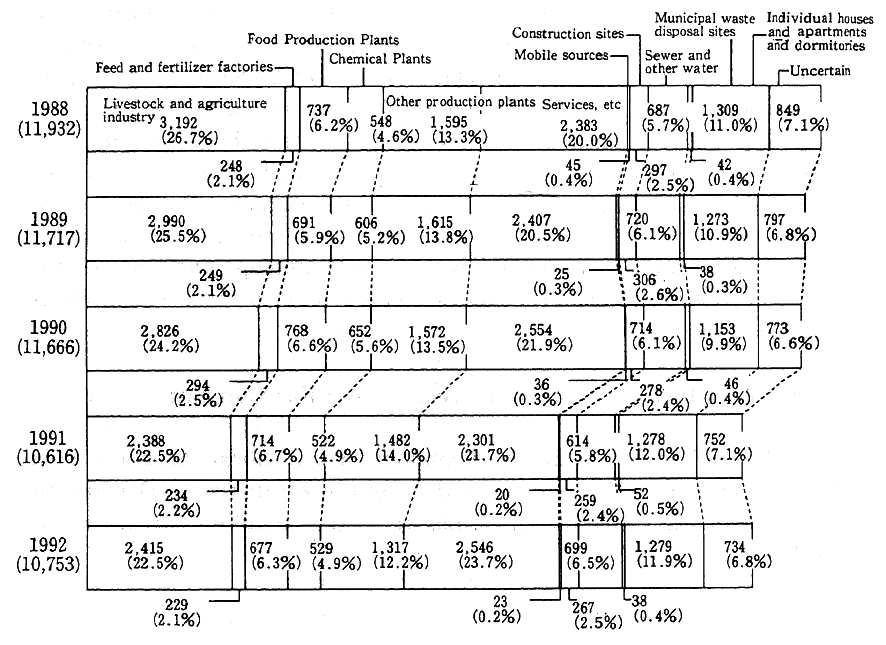
6-7-2 Preventative Measures
(1) Enforcement of Offensive Odor Control Law
Under the Offensive Odor Control Law, prefectural governors (and mayors of cities designated by local government law) designate areas where controls will be exercised on the emission of offensive odors resulting from business activities carried out at factories and other workplaces as well as formulate control standards.
As of the end of fiscal 1992, such areas were designated in a total of 1,596 municipalities, including 594 cities, 859 towns, 120 villages, and 23 wards, (accounting for about 49% of all municipalities across the nation).
When it is recognized that the surrounding living environment is severely affected because levels of foul odors accompanying business activities in designated areas do not attain standards, prefectural governors (or empowered mayors in administrative ordinance cities) can make recommendations for improvements and issue orders to the operator of the business site to take steps for improvements.
In fiscal 1992, there were four cases where recommendations for improvements were made, and there were no cases in which orders for improvements were issued. In addition to the above measures based on this law, there were 5,411 cases in which administrative guidance was provided to odor-generating business establishments in control areas.
(2) Upgrading of the Offensive Odor Control Law
Every year there are many complaints about foul odors caused by substances other than ammonia and the 12 other substances designated under the Offensive Odor Control Law, the emission of which are controlled under this law. Studies of these substances are being conducted.
In fiscal 1993, based on studies carried out to date, the law designated 10 additional substances including toluene, which is the cause of foul odors in organic solvent and burning-related odors, and the law
was expanded to control these substances.
(3) Improving Foul Odor Evaluation Methods
Under the Offensive Odor Control Law, gas chromatography devices are being used to measure concentrations and control emissions of foul smelling substances. Because of the need to make areas with low concentrations subject to monitoring, studies and research are being carried out for the establishment of optimal methods for monitoring and evaluating each type of foul odor, and revisions are being made in offensive odor monitoring methods (1972 Environment Agency Directive Number 9) to make it possible to sample and monitor such odor emissions at the optimal time of day.
Basic research is also being carried out in areas related to the development of foul air sensors to determine whether air is meeting control standards.
(4) Improvements in Offensive Odor Prevention Technologies
To enable the managers of various public agencies to provide proper guidance for workplaces emitting foul odors, depending on the type of emitting source and the conditions of the surrounding area, the Environment Agency has collected information on technologies that effectively prevent foul odors and is carrying out activities aimed at disseminating this information across Japan.
Chapter 7. Water Pollution-Current State and Policies
7-1 Water Pollution-Present Levels and Contributing Factors
7-1-1 Present Water Pollution Levels
Measurement surveys carried out in fiscal year 1992 on water pollution levels in public water areas in Japan produced the following results :
The percentage of samples where levels of toxic substances harmful to human health, such as cadmium, exceeded environmental quality standards, was extremely low, at 0.01%.
The percentage of samples where levels of trichloroethylene and tetrachloro- ethylene exceeded quality limits set for these substances in April 1992, was also extremely low, at 0.02%. (Refer to Table 7-1-1)
Table 7-1-1 Rates of Detection of Hazardous Substances Exceeding Environmental Standerds
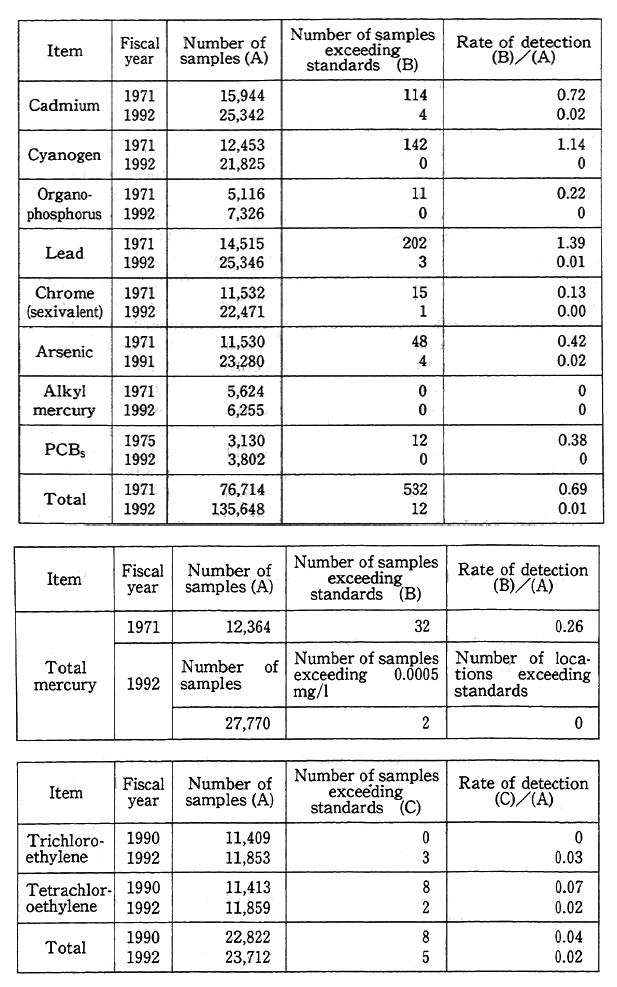
Remarks: 1. Surveyed by the Environment Agency.
2. The total for FY1971 does not include PCBS-
In 1991, there were 3,149 water areas in Japan which environmental quality standards are applied to, comprised of 2,433 rivers, 130 lakes and 586 coastal waters. Of this number, the water in 75.2% complied with officially recognized quality standards for organic pollution, BOD and COD (75% in 1991). Classifying water areas by water body types, the percentage of rivers which complied with these standards remained the same at 75.4% ; the percentage for lakes and reservoirs increased from 42.3% to 44.6%, and the percentage for coastal water areas increased slightly from 80.2% to 80.9%. Thus, the percentage of cases in which water quality failed to reach recognized standards was conspicuously low for lakes and reservoirs, inland bays/coastal inlets, inland seas and other predominantly enclosed water areas. The percentage of rivers and streams in urban areas which reached quality standards was also considerably low. (Refer to Table 7-1-2, Figure 7-1-1 and Figure 7-1-2)
In addition to the types of water pollution covered in these surveys, there are many other conditions which have substantial environmental consequences. Some of these include the pollution of groundwater by trichloroethylene and other chemicals ; the pollution of river mouths and bays by tin compounds; accidents resulting in large outflows of toxic substances into public water areas. Additional factors, such as the long-term turbidity caused by dam construction; natural acidification, caused by volcanic activity, of rivers and lakes; and the discharge of thermal effluent from power plants into public water areas, also sometimes affect the deterioration of the water environment.
Fig. 7-1-1 Pollution of Major Lakes, Swamps, and Inner Beys(FY 1992)
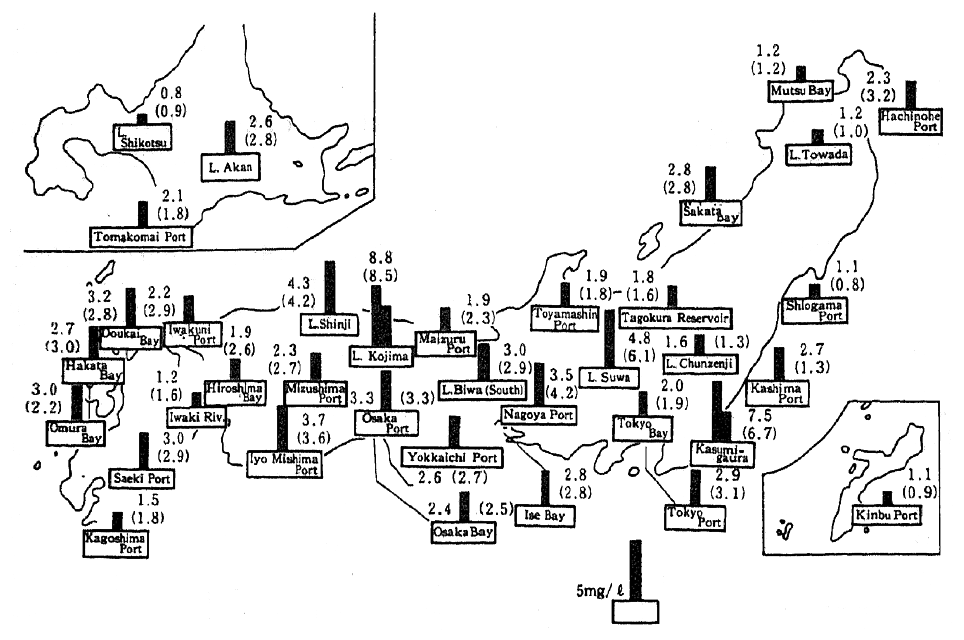
Remarks; 1. Surveyed by the Environment Agency
2. The figures are the annual average values of COD (unit : mg/1).
3. The figures in parentheses are those monitored in FY 1991.
Fig. 7-1-2 Pollution of Major Rivers (FY 1992)
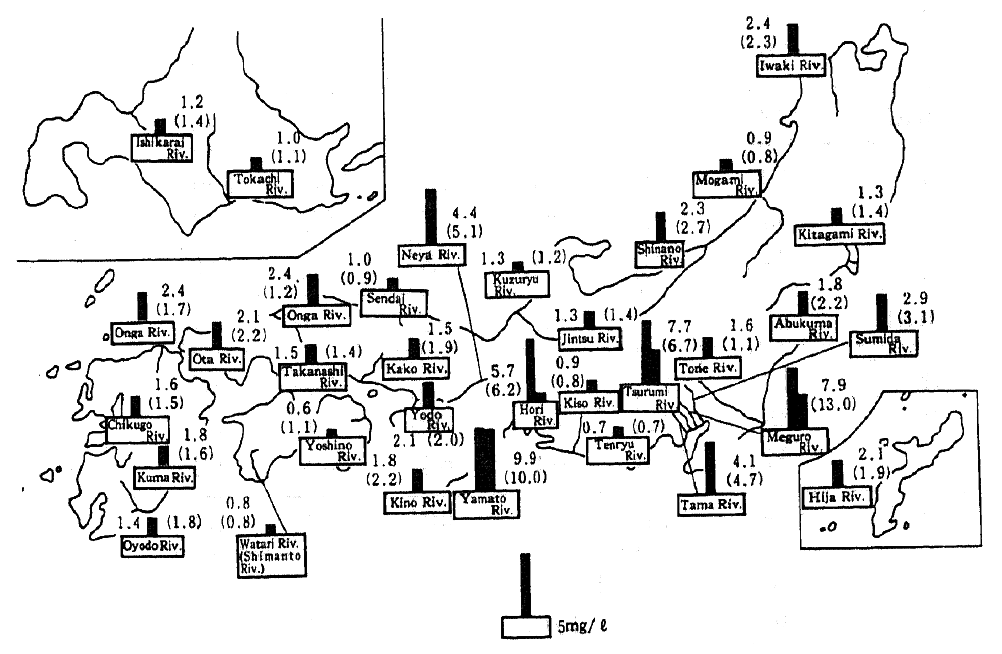
Remarks; 1. Surveyed by the Environment Agency
2. The figures are the annual average values of BOD (unit: mg/I)
3. The figures in parentheses are those monitored in FY 1991.
Table 7-1-2 Attainment of Environmental Quality Standards
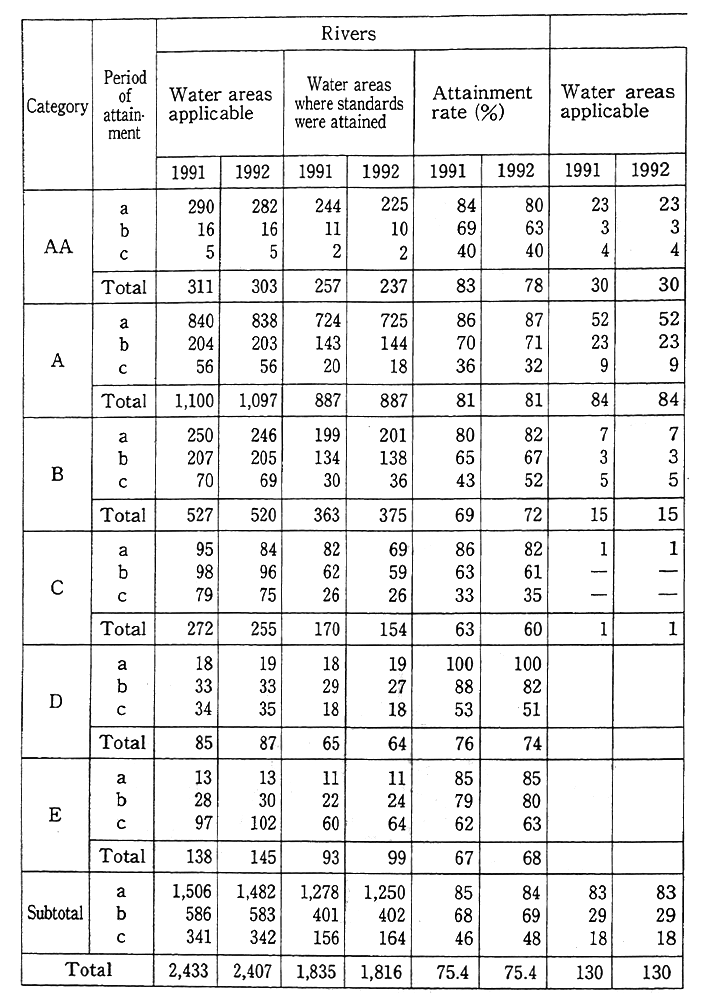
Remarks: Of the Water areas to which types were monitored in FY 1992 were classified under their type in FY 1991 and those which were were monitored in FY 1991 were classified under their type in FY 1990.
7-1-2 Causes
Although the reinforced effluent regulations for factories have been effective in improving water quality, there has been a delay in coping with household wastewater because of insufficient or ineffective systems, including sewerage disposal.
The accumulation of pollutants can occur easily in bays, inland seas, lakes and other enclosed water areas. It is also due to socioeconomic factors, such as the concentration of population and industry in littoral areas. The construction of sewage treatment plants is not keeping pace with the urbanization taking place in catchment basin areas, and domestic effluent from the growing populations in these regions is bringing a worse and worse water environment.
Consequently, in recent years, it has become increasingly urgent to formulate policies to deal with pollution caused by organic matter, particularly caused by domestic effluent. Other developments which need to be addressed include the increase of water pollution caused by non-point sources-those which have no specific source-resulting from run off from urban areas, land under development, and agricultural land ; and pollution resulting from the release of nutrients accumulated in bottom sediments, and nutrients in precipitation.
7-2 Environmental Damage Caused by Water Pollution
7-2-1 Drinking Water Sources
Rivers, streams and other surface water account for approximately 70% of all drinking water sources, and water pollution in these public water sources is considerable. Underground water, which accounts for the remaining 30% of drinking water sources, has traditionally been of a high quality. However, pollution from substances such as trichloroethylene is increasingly apparent. In fiscal 1992, accidents occurred at 79 sites which resulted in some form of pollution to water used for domestic purposes.
In recent years, the increase of nutrients in reservoirs and other Water areas has led to excessive algae growth, which in turn has produced foul odors. In fiscal 1992, 106 water utilities had to deal with these types of problems, which affected a population of approximately 15,800,000 people.
Water utilities have initiated a number of projects in response to growing pollution of drinking water supply sources, including the installation of high grade purification and treatment plants, to maintain a Safe supply of drinking water for the public. The escalation of pollution is thus placing a heavy burden on the resources of water utilities and Pushing up the cost of water treatment.
An adequate supply of safe, unpolluted water is an essential requirement for any society. As far as possible it is necessary to prevent Pollution of drinking water supply sources, and hence the quality of Water. The preservation of water quality will be an increasingly important topic in future environmental discussions.
7-2-2 Industrial Water
Industry is dependent on surface water sources, such as rivers, for 70% of its water needs. Approximately half of this volume comes from industrial water supply sources. Water serves a variety of purposes, including use as a washing agent, as a raw material, and other general uses in manufacturing processes. The pollution of water sources also affects the quality of water used by industry.
Also in the qualitative treatment of water, there are cases in which problems in treating water arise due to the generation of sludge by river pollutants.
7-2-3 Agricultural Water
In recent years, the increasing flow of polluted water from urban areas into rural water systems has given rise to serious problems, which has affected the quality of water used in agricultural production andthat used in every-day life by rural communities.
The present situation of agricultural damage caused by the pollution of agricultural water is indicated in Table 7-2-1, over 1,175 districts (5 hectares and over) with a total area of 86,200 hectares. The damage caused by discharges of effluent from urban household areas -and communities in rural areas-is the greatest, affecting 84% of the total area of polluted farmland. (Refer to Table 7-2-1)
A comparison of the findings set out below with those of a survey done in 1985 shows that the number of districts affected has increased by 10%, while the total area of affected farmland has declined by 2.9%. The total area of land affected since the last survey is 24,000 hectares, and of this total, 91 % was due to pollution from urban wastewater effluent.
Table 7-2-1 Number and Area of Districts with Agricultural Water Affected by Sources of Pollution
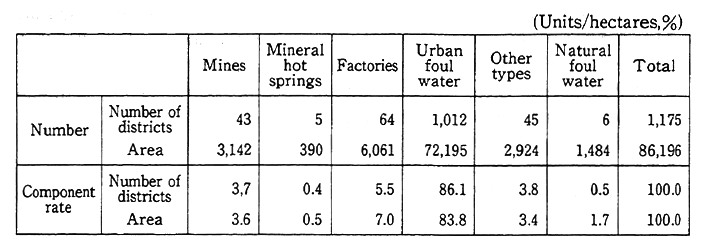
Remark : Surveyed by the Ministry of Agriculture, Forestry, and Fisheries.
7-2-4 Fisheries
The damage to fisheries caused by water pollution can be summarized in the following categories:
(A) The deterioration of fishing grounds due to factors such as the accumulation of throwaways.
(B) Extinction of marine life, and the decline of marine industries due to factors such as oil pollution, and red tides.
(C) Unsalability of hauled fish or drops in fish prices due to bioaccumulation, absorption of heavy metals, PCBs, and other toxic substances.
(D) Staining and erosion of fishing vessels and fishing equipment due to oil pollution and so on.
An outline of idiopathic damage to fisheries in fiscal 1992 is given below. (Statistics taken from reports prepared by prefectural governments)
Total number of incidents reported 233 (251 in fiscal 1991)
Oil pollution 58 (43 in fiscal 1991)
Red tides 31(30 in fiscal 1991)
Amount of damage in yen
Total ¥718,600,000 (Fiscal 1991 ¥2,947,420,O00)
Oil pollution ¥195,870,000 (Fiscal 1991 ¥579,890,OOO)
Red tides ¥441,800,000 (Fiscal 1992 ¥1,746,970,O00)
With respect to the contamination of fish and shellfish, the fishing industry continued to set dietary guidelines and self-regulation standards for mercury levels in nine water regions; for PCB levels in one Water region, and for dormn insecticides in seven water regions.
7-2-5 Other Areas
A survey conducted by the Environment Agency on water at 406 beaches on the sea, lakes, and rivers found the water quality almost in good condition. There was one beach which needs some measures to reduce coliform groups.
7-3 Measures for the Prevention of Water Pollution
7-3-1 Establishment of Environmental Quality Standards
Two sets of environmental standards have been formulated for pollution levels in public water areas; one is related to health standards and the other is concerned with the actual living environment.
With regard to health standards, one set of regulations has been set for all public water areas. In the case of living environment standards, public water areas have been categorized according to their use, and standards set for each of these categories.
In March 1993, standards were revised for 23 types of toxic substances, including cadmium, lead and other heavy metals, trichloroethylene and other. organochlorine compounds, and simazine and other agricultural chemicals. Furthermore, acceptable levels and standards were established for additional substances, referred to as "items for monitoring", and efforts to gather data on these items were increased to prevent the development of pollution problems.
As the living environment items of Environmental Quality Standards, each EQS level of BOD, COD and so on is established. Additionally, to prevent the eutrophication in water areas, in August 1993, standards for total nitrogen and total phosphorous levels in coastal waters were added to those already set for these substances in lakes and reservoirs.
With respect to the removal of sediment containing toxic substances, provisional standards have been set for sediments containing mercury and PCBs.
7-3-2 Tightening Controls over the Discharge of Effluent
(1) Increasing the number of pollutants covered by regulations and stiffening standards for pollution levels.
Uniform standards on effluent have been introduced nationwide under the Water Pollution Control Law to protect the quality of water in public water areas. These standards set maximum acceptable levels for pollutants in water discharged from factories and other facilities.
In March 1993, regulations concerning the levels of toxic substances in effluent were revised. Stricter standards were set for 13 kinds of toxic substances; including seven types of organochlorine compounds, such as dichloro methane, and four types of agrochemicals, such as simazine. Maximum acceptable levels for lead and arsenic were also lowered. These new regulations came into operation on February 1, 1994. The revised standards are shown in Table 7-3-1.
Further, to prevent the build up of nutrients in inland bays/ coastal inlets, inland seas and other enclosed waters, standards for nitrogen and phosphorous levels in effluent were set, and came into effect as regulations from October 1, 1993.
(2) Establishment of Additional Effluent Control Standards
In those water areas where it proves difficult to reach and maintain uniform national environmental standards for effluents, it is possible for prefectural governments to establish more stringent additional effluent control standards through issuance of ordinances. Since 1975, such additional effluent control standards have been established in all prefectures.
Table 7-3-1 Effluent Standards for Hazardous Substances
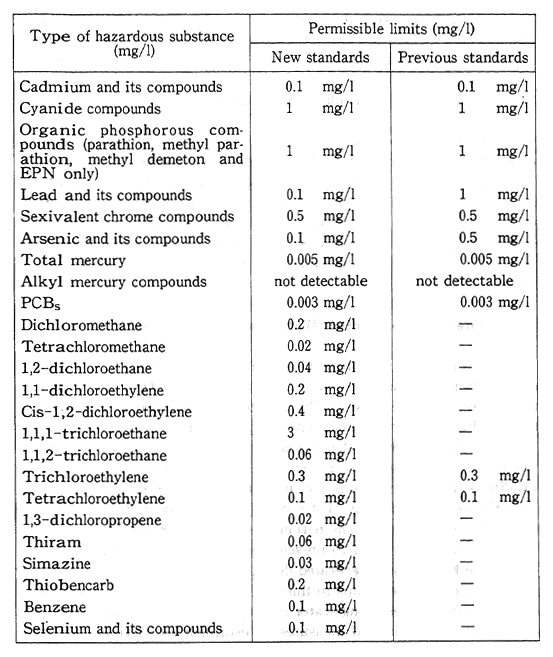
(3) Broadening the Scope of Regulations
The Water Pollution Control Law covered roughly 500 of approximately 1,100 Japanese industries when it came into operation in 1971. The number of industries within the scope of the regulations has gradually been increased, and in 1993, totaled 600. In order to extend the application for effluent facility control, individual sewerage systems for 201 to 500 persons were designated as "specified facilities of the specified regions," which are regulated only in the specified regions (Total Pollutant Load Control Areas).
(4) Studies on Unregulated Substances
Tests have been carried out on discharges from factories and other facilities to determine the levels of trichloroethane and other substances. Studies have also been done on the causes behind the deterioration of visibility in coastal waters and the consequent effects on the marine environment. In addition, the Environment Agency has studied thermal effluent which is based on an interim meeting report in 1975 to discuss measures to reduce pollution and improve the quality of water.
(5) Measures to Protect Water Sources for Public Use
In response to the the publics' rising awareness of the importance of preserving the quality of water for public use, in December 1993, at the request for advice by the Director of the Environment Agency, the Central Environment Council produced a report entitled Measures to Preserve the Quality of Water Sources for Public Use. Based on this report, a bill entitled Special Measures for the Preservation of Water Quality in Headwater Areas for the Purpose of Preventing the Specific Trouble in the Drinking Water Supply was presented at the 28th extraordinary session of the national Diet. The purpose of the regulations contained therein is to prevent the trouble in the drinking water due to the by-products generated during water processing by establishing basic policies and plans to this end, by implementing projects with the objective of preserving water quality, and by formulating comprehensive and well-planned measures to establish restrictions that will prevent water pollution.
Additionally, in November 1993, at the request for advice by the Minister of Health and Welfare, the Living Environment Deliberation Council produced a report entitled Measures to Improve the Quality of Water for.Public Use. Based on this report, the Law for the Promotion of Projects to Preserve the Quality of Water for Public Use was formulated to promote projects to preserve the water quality in bodies of water that supply safe and good quality water.
Both of the above pieces of legislation were passed by the 129thordinary session of the national Diet on February 25, 1994 and promulgated on March 4.
(6) Introduction of Regulations Covering Accidents which Result in Water Pollution
In June 1989, the Water Pollution Control Law was partially amended to require businesses to take urgent measures in the event of an accident resulting in water pollution, and inform the prefectural Governor of the action being taken to control the situation and other related matters.
7-3-3 Measures to Regulate Domestic Effluents
Domestic effluents, such as water that has been used in cooking, washing, bathing, and other daily life activities, are a major cause of pollution in public water areas.
To ensure the effective disposal of domestic effluents it is essential that sewerage systems are adequately maintained and upgraded. Moreover, in some areas, there is a specific need for improvement of facilities to process domestic effluents, such as community raw sewage treatment systems, rural sewerages in farming areas, and individual equipment treating mixed effluent. There is also a need for comprehensive programs including awareness campaigns to inform the public of their responsibility to minimize the amount of domestic effluent and to encourage responsible waste disposal practices.
The Environment Agency has been active in promoting measures to promote appropriate disposal of household effluents, issuing disposal guidelines in a 1988 report entitled Guidelines to Promote Measures for Household Effluent Disposal Policies, and sponsoring an annual Forum for Water Environment Conservation.
In June 1990, the Water Pollution Control Law was revised by amendments clarifying the responsibilities for the administration of measures dealing with the disposal of household effluent and responsibilities of citizens in this respect, and promoting the introduction of further regulations dealing with the disposal of domestic effluents.
In accordance with the amended law, prefectural governors are able to designate certain areas which require particular attention as priority areas. In fiscal 1993, 49 municipalities in 23 regions in 19 prefectures had been designated as priority areas, and 319 municipalitiesin 113 regions in 40 prefectures were designated as of March 31, 1994.
Assistance was provided to municipalities that have formulated Programs to Promote Reduction in Effluents and were engaged in installation of facilities for water purification, recovery of oil, and recycling soap in areas characterized by especially high levels of pollution from domestic effluents.
In efforts to raise awareness of the importance of preserving the quality of the living environment and water in public water areas, the Ministry of Health and Welfare and the Ministry of Construction have designated September 10 as "Sewerage Promotion Day". Additionally, the Environment Agency, the Ministry of Health and Welfare and the Ministry of Construction have designated October 1 as "Individual Sewerage Treatment Tank Day".
7-3-4 Development of Sewer Systems
The construction and maintenance of sewer systems is essential to sustaining the healthy development of cities, raising levels of public hygiene, maintaining a good living environment, and preserving the quality of water.
The construction and maintenance of sewer systems is progressing under five-year sewerage system development programs. The Seventh Five-year Sewerage System Development Program commenced in 1991 with a total budget of ¥16,500 billion. Under this plan efforts are being focused on upgrading sewer systems in medium and small size municipalities whose facilities lag behind those of other areas. The Ministry of Construction has adopted a basic policy of promoting effluent treatment projects, including high-level processing, with the aim of reducing overall pollution levels in enclosed water bodies such as lakes and reservoirs, and water pollution in general. The Ministry places priority on attainment of environmental standards for water, prevention of flooding in urban areas, improvement of the living environment, preservation of the natural environment in and around lakes and reservoirs, and improvement of living standards in farming, forestry, and fishing communities, as well as sewerage processing and effective use of sludge obtained from sewerage. A list of projects under the Seventh Five-Year Development Program is given in Table 7-3-2.
During fiscal 1993, the third year of the Seventh Five-year Sewerage System Development Program, the policies described in the following sections were implemented to upgrade sewer systems.
Table 7-3-2 Project Expenditures under the Seventh Five-Year Sewerage System Development Program by Type of Project
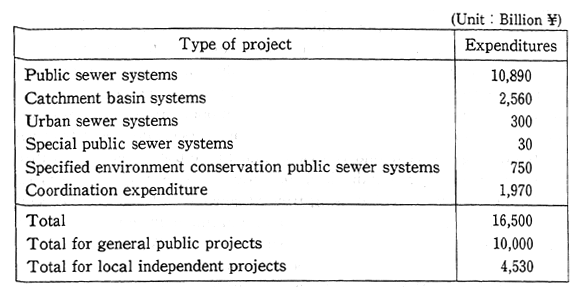
Remark : Based on data from the Misistry of Construction
(1) Sewer Construction and Management Projects
Expenditure for sewer construction and management projects in fiscal 1993 was ¥2,810 billion (under the initial budget). Activities undertaken included 1,258 public sewer construction projects, 117 basin sewer construction projects, 339 urban sewer channel construction projects, 2 special public sewer construction projects, and 507 special public sewer construction projects related to environmental conservation.
As a result of these projects, at present, about two million additional people a year have access to sewer facilities, and at the end of fiscal 1993, about 49% of the population had access to such facilities.
In areas that need large-scale upgrading of these facilities, the Environment Agency is executing a Special Emergency Sewer Construction Program. Activities under this program include the coordination of this work with subsidized construction projects and active encouragement of individual local projects.
In a related area, the Ministry of Construction is promoting a Come Back Aqua Topia campaign in 33 cities. This campaign is based on an awareness of the link between upgrading sewer facilities and assuring supplies of good water for public use and it is aimed at deepening the appreciation of citizens for the importance of having clean water. In those regions that do not yet have sewer facilities, the Ministry is continuing with various model projects on underground water courses, and conducting similar projects for drainage/sewer systems for enclosed water bodies, such as lakes and reservoirs.
To respond to the needs of urban residents for relaxing and refreshing lifestyles and to recover the quality of urban environments, including streams flowing through urban areas, a number of related projects are under way. These include 4 model projects for sewage disposal, 11 model sewage water recycling projects (2 additional projects started during the year under review) that make use of recycled water for toilets and other non-drinking purposes, and 36 model projects (9 newly started) that involve using treated sewage water and rainwater for growing greenery and construction of walking paths near processing facilities to make them more neighborhood-friendly (Water Square Plan Projects). Other related projects include implementation of model projects to encourage the use of construction materials made from recycled sewage sludge by making active use of such materials and putting in place sewer facilities that make good use of and add value to the space, processed water, sludge, and other by-products by incorporating a variety of urban services and functions. Projects of the latter type which act as the focus for promoting the strategic upgrading of urban environments and provide a model for future sewerage projects were carried out in Tokyo and Kobe. In addition sewerage projects which contribute to maintaining urban functions in districts with heavy snowfall were carried out in 11 cities and Aqua Park Model projects involving combining sewerage processing facilities and parks were carried out in 7 locations (2 newly started).
(2) Formulation of a Comprehensive Sewage System Development Program
To formulate a comprehensive sewer system development program which would serve as the basis for the design of systems for different water catchment basins and serve to attain and maintain the environmental standards for public water sources, the Ministry of Construction conducts surveys in various regions throughout Japan. Through the end of fiscal 1992, surveys were being conducted in 190 areas, and in fiscal 1993, surveys were conducted in 3 new locations, including the Suo Sea off Yamaguchi-ken.
At the end of fiscal 1993, comprehensive sewer development plans had been developed for 76 catchment basin areas.
(3) Technical Development, Surveys and Studies
The Ministry is conducting surveys and various other activities to facilitate the promotion of sewage development projects. These include evaluating basic policies for the development and management of sewage systems, devising methods to streamline the design and operation of sewage facilities, devising measures to improve the ability of sewage systems to dispose of rain water, improving the efficiency of sewage systems and their water environment, evaluating the effectiveness of administration and maintenance facilities, developing smallscale sewage system technologies, developing new ways to dispose of sewage sludge and respond to changes in the environment, developing methods to effectively convert material collected in sewage systems into usable resources and sources of energy, adapting to greater diversity in the roles of sewer facilities.
The Ministry has also focused energies on making use of biotechnology in new effluent processing systems (Biofocus WT), and in fiscal 1990 began projects in seven locations to apply these systems, including facilities of the Japan Sewer Development and Management Project Corporation and in Miyakonojo city in Miyazaki Prefecture, Nagoya in Aichi Prefecture, and Futamicho Town in Mie Prefecture. The Ministry is also engaged in model projects to make use of other new technologies to further the active introduction of such sewerage treatment technologies and methods and contribute to the upgrading and improving efficiency of sewerage treatment technologies.
(4) Japan Sewerage Development and Management Project Corporation
In addition to construction work on final processing facilities commissioned by local governments, the Japan Sewerage Development and Management Project Corporation also trains sewerage technicians, conducts tests for the certification of new technologies, develops sewerage system-related technologies, conducts tests and research on sewerage systems, and carries out surveys to evaluate new technologies.
Set up in 1986, the Corporation has carried out inter-regional sewage and sludge treatment projects, called Ace Plans making use of funds provided from the Treasury Investments and Loan Account. In fiscal 1993, Ace Plans were being carried out in three areas ; the Hyogo region (east block and west block), northeastern Osaka, and southern Osaka.
7-3-5 Development of Pollution Measurement and Monitoring Systems
(1) Monitoring Water Quality in Public Waters
The Environment Agency, under the Water Pollution Prevention Law, subsidizes costs for the formulation of monitoring plans and for water quality surveys related to the continuous surveillance of water quality in public water areas designated for such programs by prefectural governors and the mayors of cities designated by ordinances. The subsidies were also provided in fiscal 1993. These programs are primarily focused on those waters which have been designated under environmental standards and for which there is a strong need for water quality monitoring.
In addition, the Ministry of Construction, from its point of view as supervisor of rivers, monitors water conditions in important areas along Class I rivers nationwide and conducts water quality tests.
A vital part of improving the efficiency of continuous monitoring systems is the upgrading and maintenance of automatic surveillance and monitoring systems. Through the end of fiscal 1993, the Agency had assisted prefectural and designated cities and local governments with the installation of automatic monitoring systems at 169 locations.
Also, in its role as a supervisor of rivers, the Ministry of Construction monitors pollution in the major water areas of Class 1 rivers. Through the end of fiscal 1992, the Ministry had installed automatic water surveillance and monitoring devices at 128 places in 65 different water systems and, in order to centralize water quality monitoring, is promoting the use of telemeters. Through the end of fiscal 1992, these devices had been installed in 116 locations.
Although there are officially recognized methods for the measurement of pH and DO using automatic surveillance and monitoring devices, no such methods exist for the measurement of COD levels. Research is currently being conducted to improve the methodology of measuring COD levels using automatic devices.
In other related activities aimed at strengthening the infrastructure for water pollution research, the Environment Agency is assisting local environmental pollution research institutes and other organizations by providing funds for the procurement of analysis equipment. Also, working with the guidance and cooperation of environmental departments of the prefectures and regional offices of the Ministry of Construction, the Environment Agency and the Ministry of Construction have conducted surveys of water quality as reflected in water organisms through the surveying efforts of the general public. For this purpose, in fiscal 1993, environmental departments of the prefectures organized the efforts of 35,000 persons and regional offices of the Ministry of Construction secured the cooperation of 12,O0O persons.